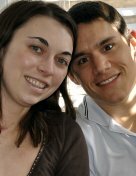234 Goodman Street, Cincinnati, Ohio 45219 | (866) 941-UCNI (8264)
Cerebrovascular Center
Pediatric Stroke
Although stroke is generally regarded as a disease of old age, it also can occur in younger adults, children and even babies.
There are two kinds of stroke, and children can suffer either kind: ischemic (caused by a blockage of blood flow to the brain) or bleeding (caused by a ruptured blood vessel). About 3,000 strokes are suffered by children and babies in the United States each year. A bleeding stroke is more common in children than adults. About half of the strokes in children are the bleeding type, compared to about 20 percent in adults.
If you suspect that a child or adolescent is having a stroke, call 9-1-1 immediately.
Although the University of Cincinnati Neuroscience Institute does not typically treat pediatric patients, its internationally recognized research team has studied stroke in children.
The causes of stroke in children and adults are often quite different, according to Dawn Kleindorfer, MD, Associate Professor of Neurology and a member of the Greater Cincinnati/Northern Kentucky Stroke Team. Children typically do not have the standard risk factors that adults have (e.g., high blood pressure, diabetes, smoking), although these conditions are being seen more and more in adolescents.
Risk factors for stroke in childhood or infancy include sickle cell anemia, heart disease or defects, blood disorders, meningitis, high blood pressure, dehydration (rarely), and complications within a year of contracting chickenpox.
Strokes in children can be caused by:
- a blood clot that blocks blood flow to the brain
- a brain aneurysm that ruptures
- an arteriovenous malformation (AVM) in the brain
- severe or mild trauma to the head
- severe or mild trauma to the neck, resulting in carotid or vertebral dissection
The symptoms of stroke in older children and adolescents are thought to be fairly similar to those in adults, according to Dr. Kleindorfer. These symptoms include weakness/numbness on one side, trouble with language, and difficulty seeing or walking.
Signs of stroke in children and babies are less definitive and can make diagnosis difficult.
Signs of stroke in children:
- headache
- weakness in one arm or leg
- one side of the body falls asleep
- loss of consciousness
Signs of stroke in babies:
- excessive crankiness
- excessive sleepiness
- inability to feed
In general, acute strokes in children are difficult to identify. Stroke symptoms in babies can be especially challenging. Babies often do not have symptoms just on one side, and they cannot communicate that something is wrong. All children are more likely to have seizures with their stroke, which makes the diagnosis even more challenging.
Treatment for children who are diagnosed with an ischemic (clotting) stroke is still controversial, according to Dr. Kleindorfer. The clot-busting drugs that have been approved for early treatment of stroke in adults have not been tested in children. Many stroke specialists have used this medicine in older adolescents following a diagnosis of stroke, but not in younger children. As a result, Dr. Kleindorfer said, more research is needed.
Because the brains of children are have high “plasticity” and are capable of adaptation, children who suffer a stroke have the potential for favorable outcomes. Although they may have some loss of function, they generally recover sufficiently to walk and talk.
 RSS Feed
RSS Feed
